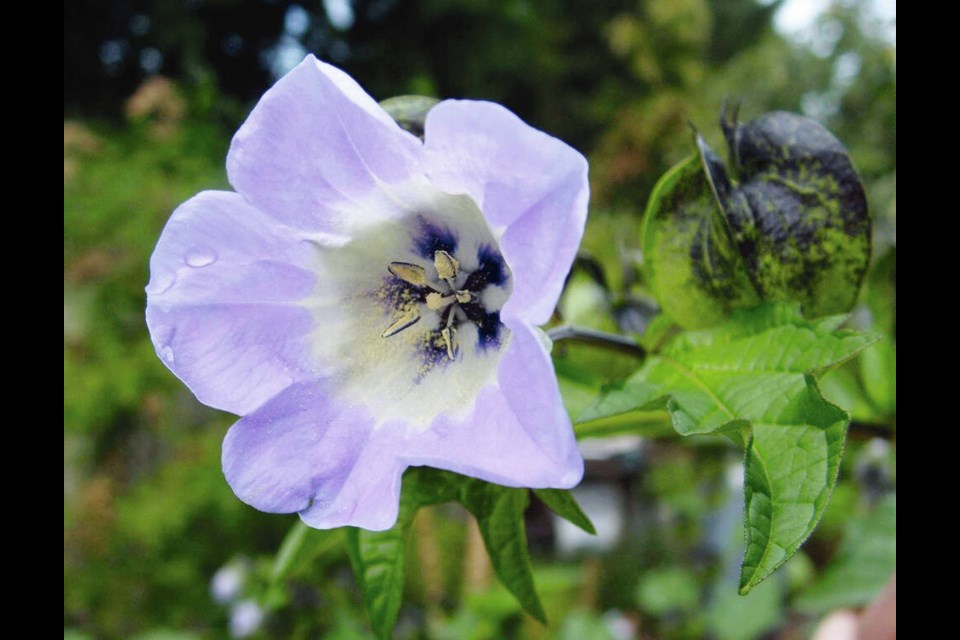Dear Helen: Last year, for interest and colour, I planted a few nasturtium seeds around my blueberry bushes. From those plants, a volunteer nasturtium appeared this summer. It grew to spread out over a large section of ground and poured over a cement wall. Early this month new flowers were still appearing. I’d like to retrieve seeds from this plant to sow in the spring for a repeat of this year’s cheering, Olympian performance. Please explain how to do this.
D.C.
I gather that this year’s plant did not repeat the same growth habit of the nasturtiums you planted last year. Seeds you take from this year’s unusual plant may not repeat the same pattern of growth as this year’s marvel as seeds gathered in usual home garden conditions often revert to various characteristics in the seed line’s heritage.
Of the many flowers that habitually self-sow in my garden there have been startling variations. Last year, shoo-fly (Nicandra) seedlings arising from the previous year’s seed shedding grew into small, bushy trees, far larger and sturdier than the usual size but still adorned with beautiful blue flowers.
Self-sown plants are very often larger, stronger, healthier and generally more imposing than the same flower or vegetable sown in the current year. As in most years, the self-sown kale plants in this year’s garden are far more robust than the ones I sowed this spring.
Nasturtiums commonly self-sow without any help from us. Presuming your giant plant has set seeds, some will likely germinate on their own next spring or early summer.
If you want a seedy security blanket, look around the plant for large seeds that have turned tan and dropped off. Gather them up and spread them on paper in a dry, coolish spot in the house to dry thoroughly before storing them for the winter in a paper bag or envelope in a uniformly cool, dry place.
Dear Helen: In my newly acquired garden the peony top growth has shrivelled and browned. Do I leave it on the plants over the winter or cut it away?
W.D.
Peony stems are best removed as soon as they have faded in the fall, for aesthetic reasons and, more importantly, as a disease prevention measure. Peonies are susceptible to fungus problems and the old foliage can harbour disease organisms. I don’t compost the spend top growth.
Once all the stems are removed, clean the area well and apply a light dusting each of lime and bone meal, covered with a shallow mulch layer of a nourishing compost.
Dear Helen: Over the past three years, creeping field bindweed has been taking over my food garden. Efforts to dig it up, kill the leaves with vinegar, and smother it have not reduced the weed’s vigour at all. I do not want to use herbicides. What to do? Because of work and family commitments my gardening time is limited.
T.J.
Unfortunately, field bindweed (perennial morning glory, Convolvulus arvensis)) is a highly persistent, perennial weed that grows and spreads from wide-ranging, deep roots as well as by seeds.
First, never let the plants flower and set seed. The seeds remain viable for decades. Try to keep new shoots dug up. This is most easily done when the ground is damp and soft. Use a digging fork rather than a shovel, to avoid slicing roots into many sprouting pieces.
Once an area has been dug and de-rooted as thoroughly as possible, try laying thick cardboard over it and cover the cardboard with leaves or some other organic mulch. In this way you might be able to maintain some weed-suppressed areas while keeping new shoots removed from areas you want to keep in use.
GARDEN EVENT
Mixing it Up 2025. The Victoria Master Gardeners are hosting their biennial Mixing it Up Conference on Saturday, February 1, 2025, at the Mary Winspear Centre in Sidney. The theme is “Beyond Beauty.” The conference will include five speakers who will share how adding biodiversity creates healthy and beautiful gardens. Topics include urban trees, designing with native plants, citizen science in the garden, and “Mind What You Sow.” For more information on the talks and the speakers, and to register, please go to mixingitup.org or mgabc.org. Early bird fee until Nov. 30 is $75.



